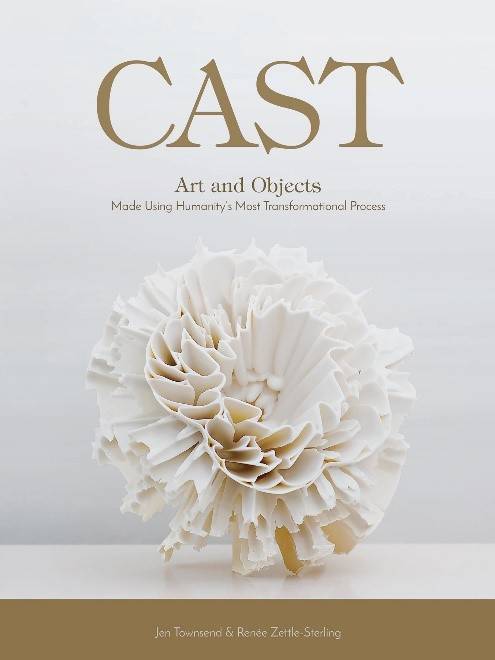Cover of CAST, winner of 8 book awards

Out of the Mold with Renée Zettle-Sterling
There is something monumental about CAST: Art and Objects Made Using Humanity’s Most Transformational Process (Schiffer, June 28, 2017). It begins with the cool opulence of its ivory and gold dust jacket and continues with the compelling juxtapositions inside its covers of cast objects of myriad materials.
A book publication is a special occasion in the life of any academic, and when the project is particularly sweeping, both exhilaration and exhaustion are parts of its DNA. The effect on the reader is much the same – its 803 images and essays provide unexpected resonances, and at 441 pages in an oversized format, it impresses itself in the reader’s arms.
The concept taps something primordial. Liquid transformed into a solid, semi-solids taking on new shapes. Feats of engineering and material science to create a method for reproduction on various scales, or so ephemeral that the mold itself is consumed in the process of making a single piece.
Its authors, its curators, are a team who have known each other for 17 years. GVSU Art and Design Professor Renée Zettle-Sterling met studio jeweler and author Jen Townsend through their membership in the Society of North American Goldsmiths and developed a partnership after Renée took the helm of the society as its President and Jen was appointed to the board. Three years of working closely on projects for SNAG boded well.
“No arguments on the book,” Renée observes. “We’re copasetic.”
One could say that they were alloyed together by their love of casting. Jen likes the front end of the process, working in wax and enjoying the plasticity of form, while Renée was sold on the whole messy, fiery, spitting business since her first casting class as an undergraduate. “It blew me away―it’s what made me become a jeweler and a metalsmith.”
“Now that the book is out in the world, it’s a very different experience for me. Usually, my work is stored in boxes between exhibitions. I can’t choose who sees this work. It was a process of giving 110%, being thoughtful, with great attention to making it as perfect as we possibly could over a sustained period of time,” Renée notes.
Part of the process involved gathering images, perhaps 20,000 to 30,000 viewed in all, from a variety of sources such as a Juried Art Services call for entries, direct outreach to artists, digital collections of museums, and tapping their own networks.
“Thank God for Excel – we were able to keep track of thousands of bits of information in our spreadsheets.” Renée laughs. “We contacted artists such as Chinese contemporary artist Ai Weiwei, Janine Antoni (who works in performance art, sculpture, and photography), and sculptor Rona Pondick. We contacted GVSU art alumni. We used image resources to access images of artists no longer with us. The range was huge. Looking at all of those images makes you hypersensitive to image quality.”
Sometimes as they worked to curate the images for the book and arrange them into striking interaction with one another on the page, the pair would detect a gap. They found it productive to contact colleagues and former students with specialized knowledge in an area, such as design, for suggestions of work that might fill the gap.
The dynamic organization of the work was the product of many hours on the floor with printed thumbnails of the images auditioned in broad categories. For instance, instead of a temporal sequence or arrangement by author, the book has threads such as what is the function of metal, of glass? How does a material interact with site, such as cast glass in unexpected places? Sometimes cast components are assembled into a metal sculpture or cast concrete into architecture. The book has galleries of color, texture, and airiness.
“My favorite part was organizing the images,” Renée says. “Pairing them in different ways was exciting – for instance, a vessel might appear in a jewelry chapter if it applied. I loved picking the dramatic header images for sections of the book, the headers invite you in.”
And yet, such an undertaking is never just aesthetic work. There were hundreds of image permission forms to file.
“There were an exhausting number of moving parts. Just crazy,” Renée admits. But the work has resulted in the sort of resource they both hoped for, the kind that they could use in their studios and classrooms. Renée has already seen how excited her students are about the book.
“Now the challenge is getting the book into people’s hands. The price is very attractive, and we have a publicist to help us spread the word through media, bloggers, Facebook, and the websites of contributors. We also have a new website for the project www.castartandobjects.com,” Renee explains.
As much as she loves casting and the spectrum of work that the book represents, she acknowledges that much of the glut in the world is also a product of casting on the industrial scale. Renée and Jen have a second project that will come to fruition in 2021 – it will examine the subject from a different perspective. Aptly named RECAST, this project will explore the science, industry, and entrepreneurial aspects of casting.
“We’re inspired by 3D printing and work being done through casting to document history. We were struck by the work of an architecture professor who took molds of the gas chambers to help document the Holocaust,” Renée explains.
Perhaps the cover of their next project will not be ivory and gold. But it will have the unflinching examination of artists dedicated to a form that is best appreciated from all angles.
